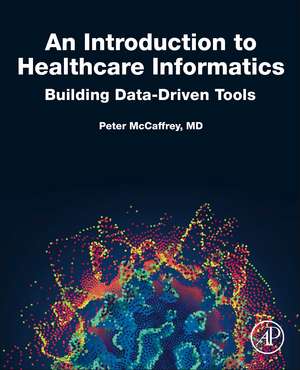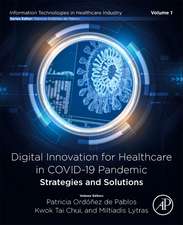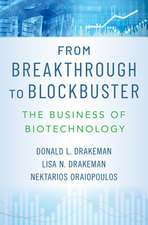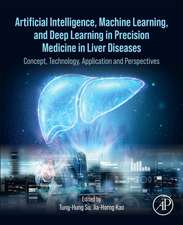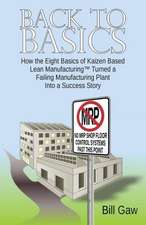An Introduction to Healthcare Informatics: Building Data-Driven Tools
Autor Peter Mccaffreyen Limba Engleză Paperback – 28 iul 2020
The book discusses topics such as data access, data analysis, big data current landscape and application architecture. Additionally, it encompasses a discussion on the future developments in the field. This book provides physicians, nurses and health scientists with the concepts and skills necessary to work with analysts and IT professionals and even perform analysis and application architecture themselves.
- Presents case-based learning relevant to healthcare, bringing each concept accompanied by an example which becomes critical when explaining the function of SQL, databases, basic models etc.
- Provides a roadmap for implementing modern technologies and design patters in a healthcare setting, helping the reader to understand both the archaic enterprise systems that often exist in hospitals as well as emerging tools and how they can be used together
- Explains healthcare-specific stakeholders and the management of analytical projects within healthcare, allowing healthcare practitioners to successfully navigate the political and bureaucratic challenges to implementation
- Brings diagrams for each example and technology describing how they operate individually as well as how they fit into a larger reference architecture built upon throughout the book
Preț: 600.66 lei
Preț vechi: 787.08 lei
-24% Nou
Puncte Express: 901
Preț estimativ în valută:
114.97€ • 124.93$ • 96.64£
114.97€ • 124.93$ • 96.64£
Carte tipărită la comandă
Livrare economică 14-28 aprilie
Preluare comenzi: 021 569.72.76
Specificații
ISBN-13: 9780128149157
ISBN-10: 0128149159
Pagini: 339
Dimensiuni: 191 x 235 x 22 mm
Greutate: 0.59 kg
Editura: ELSEVIER SCIENCE
ISBN-10: 0128149159
Pagini: 339
Dimensiuni: 191 x 235 x 22 mm
Greutate: 0.59 kg
Editura: ELSEVIER SCIENCE
Public țintă
graduate students, physicians, nurses, and several members of biomedical fieldCuprins
Section 1: Storing and Accessing Data1. The Healthcare IT Landscape2. Relational Databases3. SQL
4. Example Project 1: Querying Data with SQL5. Non-Relational Databases6. M/MUMPS
Section 2: Understanding Healthcare Data7. How to Approach Healthcare Data Questions8. Clinical and Administrative Workflows: Encounters, Laboratory Testing, Clinical Notes, and Billing9. HL-7 and FHIR, and Clinical Document Architecture10. Ontologies, Terminology Mappings and Code Sets
Section 3: Analyzing Data11. A Selective Introduction to Python and Key Concepts12. Packages, Interactive Computing, and Analytical Documents13. Assessing Data Quality, Attributes, and Structure14. Introduction to Machine Learning: Regression, Classification, and Important Concepts15. Introduction to Machine Learning: Support Vector Machines, Tree-Based Models, Clustering, and Explainability16. Computational Phenotyping, and Clinical Natural Language Processing17. Example Project 2: Assessing and Modeling Data
18. Introduction to Deep Learning and Artificial Intelligence
Section 4: Designing Data Applications19. Analysis Best Practices20. Overview of Big Data Tools: Hadoop, Spark and Kafka21. Cloud Technologies
4. Example Project 1: Querying Data with SQL5. Non-Relational Databases6. M/MUMPS
Section 2: Understanding Healthcare Data7. How to Approach Healthcare Data Questions8. Clinical and Administrative Workflows: Encounters, Laboratory Testing, Clinical Notes, and Billing9. HL-7 and FHIR, and Clinical Document Architecture10. Ontologies, Terminology Mappings and Code Sets
Section 3: Analyzing Data11. A Selective Introduction to Python and Key Concepts12. Packages, Interactive Computing, and Analytical Documents13. Assessing Data Quality, Attributes, and Structure14. Introduction to Machine Learning: Regression, Classification, and Important Concepts15. Introduction to Machine Learning: Support Vector Machines, Tree-Based Models, Clustering, and Explainability16. Computational Phenotyping, and Clinical Natural Language Processing17. Example Project 2: Assessing and Modeling Data
18. Introduction to Deep Learning and Artificial Intelligence
Section 4: Designing Data Applications19. Analysis Best Practices20. Overview of Big Data Tools: Hadoop, Spark and Kafka21. Cloud Technologies
